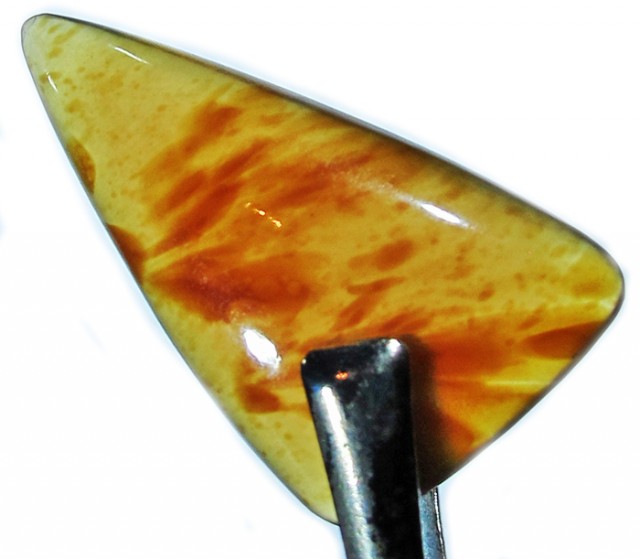
Amber Gemstone: Properties, Meanings, Value & More
 Amber is a yellowish-orange, translucent stone composed of fossilized tree resin, often with insects or plants inside. It’s been a popular material since before the Ice Age, both for understanding Earth’s history and creating diverse items.
Amber is a yellowish-orange, translucent stone composed of fossilized tree resin, often with insects or plants inside. It’s been a popular material since before the Ice Age, both for understanding Earth’s history and creating diverse items.
Is amber considered a gemstone? Because amber is not a mineral, some say it’s not a gemstone. However, most say amber’s ability to be polished and cut for adornment makes it a gemstone.
Is amber a rare gemstone? No, amber is accessible worldwide, including in the US state of Kansas where it serves as the state gemstone. However, amber from the Baltic Sea area (Baltic amber) is the most significant.
Come along as we uncover amber gemstone history, value, uses, and more!
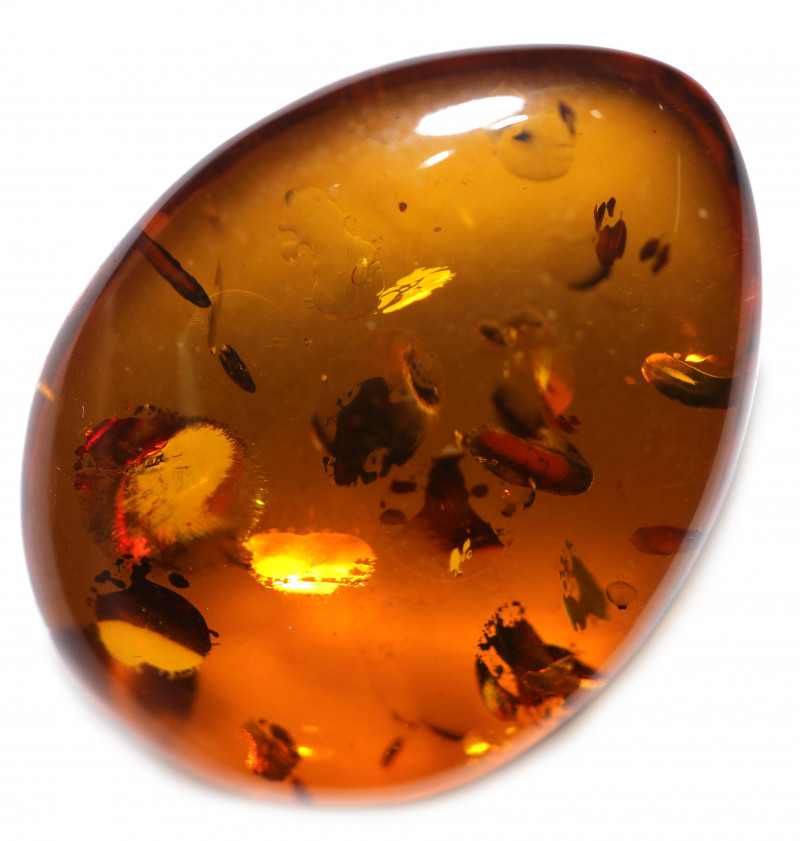
About Amber Stone
First, is amber a precious stone? No, amber is a semi-precious gemstone, and one of the few organic gemstones.
Ancient names include “elektron,” for its electrostatic capabilities — if you rub it, it attracts objects like a balloon! — along with “Denmark’s gold” and “tears of gods.”
Non-gemstone uses include amber perfume and incense. What does amber smell like? This scent is an earthy, warm combination of smoke, leather, and pine.
Who can wear amber stone? Anyone! Although, amber is a lucky zodiac stone for Leos.
While amber isn’t a wedding anniversary gemstone, traditional Kurpie weddings involve giving brides an amber gemstone necklace dowry.

Amber Specifications & Characteristics
Wondering what amber is made of? The resin contains hydrocarbons, succinic acid, oils, and resins.
What trees does amber come from? Mostly, a type of pine called Pinus succinifera and similar conifer trees dating back roughly 40 million years!
Amber may be confused with copal, a fossilized resin from copal trees. However, copal is under 30 million years old.
How can you tell real amber from fake? Check out our guide on how to test amber!
Here are all of amber’s properties:
Mohs hardness: 2-2.5
Color: Yellow, red, orange, brown, cream, or blackish; Rarely blue, green, or violet
Crystal structure: None (amorphous)
Luster: Waxy or resinous
Transparency: Transparent to opaque
Refractive index: 1.54
Density: 1.00-1.10
Cleavage: None
Fracture: Conchoidal
Streak: White
Luminescence: Sometimes fluorescence; Yellow or gray-blue in SW-UV, pale blue or green in LW-UV; Rare stones appear green, blue, or purple from intense fluorescence
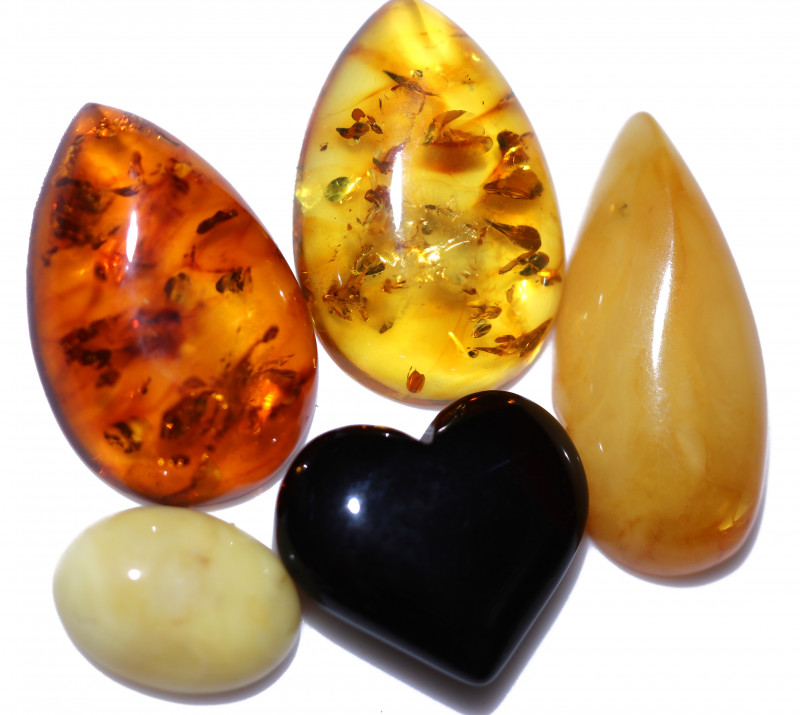
Types of Amber
Amber categories are diverse, including country, environment, transparency, and more.
The simplest classification is by color, which we’ll break down below.
Yellow Amber (Common Amber)
Yellow amber is the most common variety, making up around 70 percent of all amber. Most are Baltic, and 90 percent come from Kaliningrad in Russia. These are the well-known yellow, orange, or brown gems. The colors can be singular or multi-color.
Black Amber

Black amber is the next most common variety, making up around 15 percent. These gems aren’t pure black but rather dark shades of brown or red from dark inclusions like soil. Back-lighting will make it look a new brown, red, or blue color.
Green Amber

Green amber stone is a popular yet rare variety, at only two percent. These stones’ shades vary, with value increasing for deeper colors.
The green comes from plant inclusions, so sometimes it goes by “earth amber.” Yellow-green shades are usually natural, while many deep-green ambers have been treated.
White Amber
White amber (also “royal white” or “bony”) is a natural variety only making up 1-2 percent. This variety is never treated, as it naturally displays beautiful swirls in gray, blue, honey, or green.
Red Amber
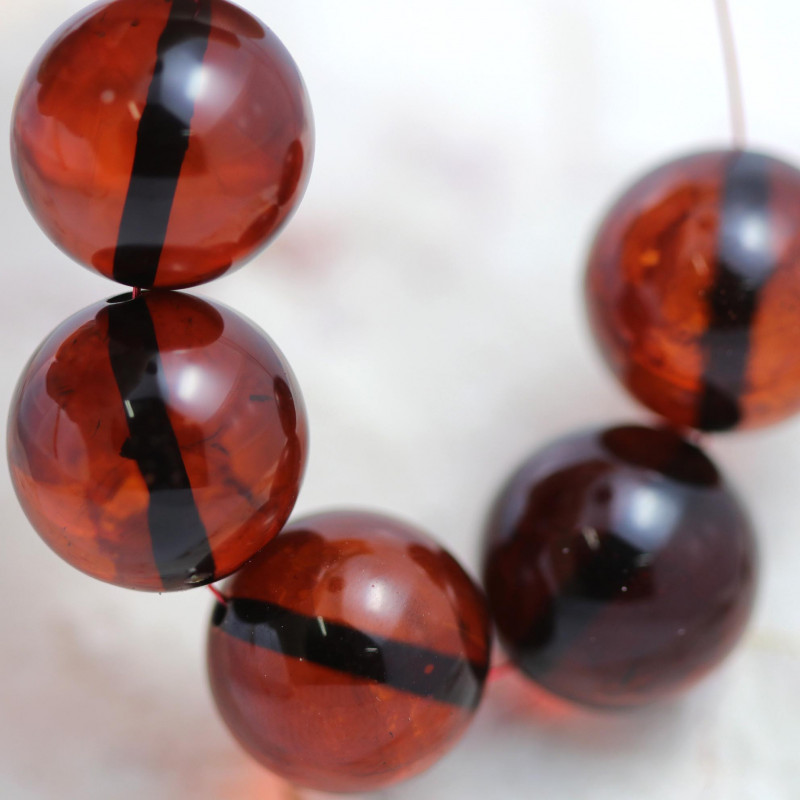
Only 0.5 percent of all amber is red, or “cherry amber,” a rusty red, golden red, or dark brown variety. The deep red color is a layer of iron salts attached to the stone.
Lastly, what is the rarest amber?
Blue Amber
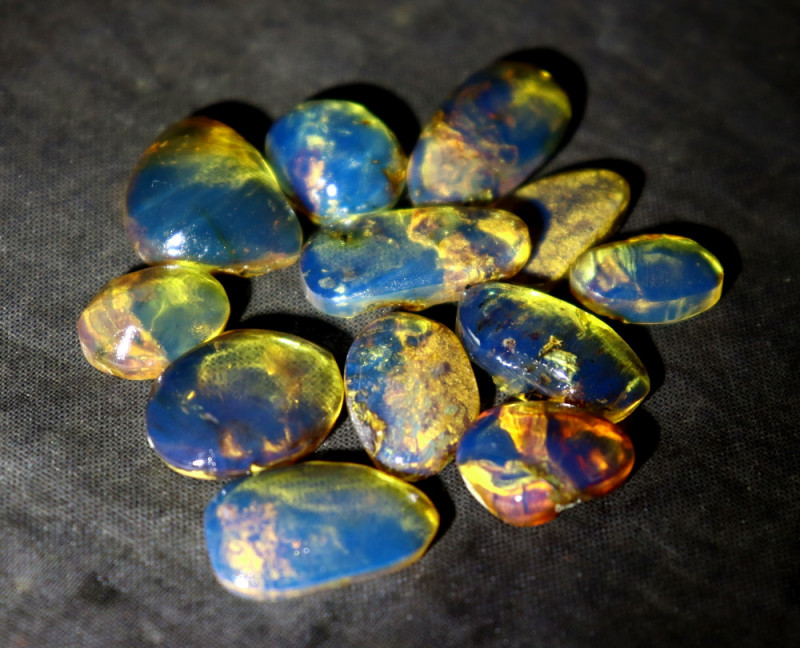
Blue amber, or “Dominican blue amber,” is the rarest, appearing yellow or brown, but becoming vibrant blue when held up to UV-light like sunlight.
Now, what’s the meaning of amber?

Amber Meaning & History
Amber’s name comes from the Arabic anbar, meaning “perfume.”
Lore surrounding the amber gemstone meaning and origins are abundant. Poland has two such legends.
The first is that amber stones washed ashore are shattered pieces of the sea goddess Jurata’s underwater palace. Her husband, Perkun, destroyed her and her palace with lightning upon discovering her affair with a mortal fisherman.
The second legend is a Kurpish tale. Forty days of rain brought a devastating flood. In anguish, the locals cried and their tears transformed into amber upon hitting the water.
Kurpie’s legend shares similarities with another ancient myth about amber, partly inspiring its nickname, “Gem of the Sun.”
In ancient Greek mythology, amber ties to Phaeton. Phaeton was the child of Helios, the sun god. After Phaeton fatally crashed Helios’s chariot, Phaeton’s sisters, the Heliades, turned into poplars that cried amber tears.
History
Part of Baltic amber’s significance is historical. Baltic amber comes from countries bordering the Baltic Sea, namely Scandinavia, Poland, and Russia.
The earliest evidence of amber use dates back to Neolithic times in modern-day Poland. During the Stone Age, Scandinavians traded amber for products from Greece and Italy via the “Amber Road”.
The first recorded remarks on the gem came from the 1st-century Roman naturalist, Pliny the Elder, who named it succinite. Ancient Romans created amber stone jewelry, dishware, and incense.
Poland is perhaps the most prolific in amber’s history, where it’s called “The Gold of the North.”
In the Middle Ages, present-day Gdańsk became the center of amber handiwork. The city’s workshops suffered setbacks when Prussian rule in 1308 banned locals from even owning amber.
The end of Prussian rule in 1466 started an amber revival that continued through the 1700s. Gdańsk artisans crafted religious and secular amber goods, the most famous being the Amber Room.
The room started as a study outfitted with nearly 100,000 amber pieces for King Friedrich I of Prussia. Russian Czar Peter the Great was so captivated by it, Freidrich gifted it to Peter, who had artisans expand it into an entire room. Sadly, Nazis dismantled everything during WWII, never to be recovered.
On a brighter note, what is the amber stone good for?

Amber Healing Properties
The color and spiritual energies within gems make them healing stones. Is amber a healing stone? Definitely!
The color “amber” combines orange and yellow, literally and spiritually. Amber is a chakra stone for the solar plexus chakra, like yellow gems, while offering the boldness and vitality of orange gems.
What are the benefits of amber physically and emotionally?
Physical Healing
Amber may provide energy from fatigue, especially from chronic pain. It’s said to boost the immune, nervous, and digestive systems. Crystal healers use it for harmonizing the brain hemispheres.
Emotional Healing
Emotional amber gemstone benefits can include easing anxiety and stress. Crystal healers recommend the stone to those going through breakups to bring healing, positivity, and recovery. They also suggest amber to reduce people-pleasing behaviors, replacing them with self-care and boundaries.
Beyond healing, does amber have any value? Absolutely!
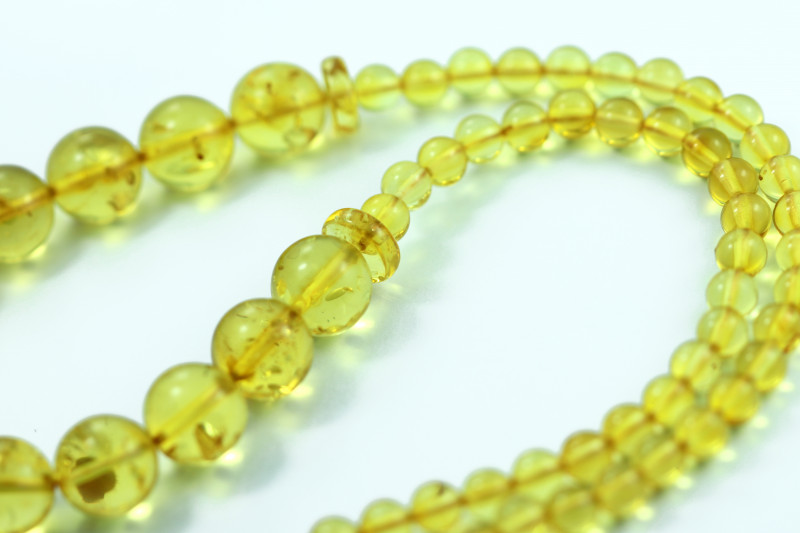
Amber Gemstone Properties
Gemstone experts grade amber slightly differently than most stones but still from similar categories: color, cut, clarity, and treatments.

Color
Tree resin starts yellow, but inclusions can change amber’s color. Roughly two-thirds are yellow, brownish, or orange. Almost all amber has brown flecks.
Red amber is the most valuable common color, followed by golden-yellow, then yellow. Deeper hues of any color are more valuable. Green or blue amber is usually the most expensive.
Blue amber comes in many shades, all of which fall on a grading spectrum from most to least valuable:
AAA: Deep cobalt blue
AA: Saturated medium blue
A: Medium blue
B: Sky blue
C: Teal
Cut
Most amber becomes polished free-form pieces, often drilled into amber beads. Beads, cabochons, or tumbled stones are popular for jewelry. Amber is rarely faceted. Opaque specimens usually become decorative carvings.

Clarity
Inclusions can raise or lower amber’s value. Perfectly clear, inclusion-free amber is rare and more valuable than cloudy. The degree of inclusions dictates amber’s clarity grade:
AAA: Inclusion-free
AAB: Opaque, uniform color throughout
AA: 15 percent or less inclusions
A: 15 percent or less inclusions; Plants and smoke dots present
B: 16-35 percent inclusions
C: 36-60 percent inclusions
D: 61-99 percent inclusions
E: Inclusions cover entirety of stone
Common inclusions are plants, insects, and pollen. Unique inclusions, like ancient creatures or extinct plants, significantly increase value.
Radiating star spangle inclusion patterns come from internal fractures but usually happen via treatments.
Carat Weight & Size
Amber may be sold in grams or carats. Most specimens are under 0.5 lbs (around 0.23 kg), though the largest currently known is a 33-lb (15-kg) Baltic specimen with an ancient lizard inside!
Because amber is light, much larger sizes have lower carat weights. A 3-carat amber is nearly 4-times the size of a 3-carat ruby. Another pro of amber’s lightweight nature is the potential for large, elaborate statement jewelry that won’t hurt to wear!
Treatments & Synthetics
Dyeing and heat treatments are somewhat common. Heating cloudy amber in canola oil can make bubbles disappear, increasing transparency. Heat treatments can also deepen color and produce the star-spangled inclusion.
Dyeing, or dyeing and heating, amber can produce green or red hues. Heat can also make the stone more durable.
The first synthetic amber from 1879 was amberoid, a collection of amber fragments bonded together that’s still manufactured.
Over time, real amber stone darkens in color, while amberoid usually turns white. Glass, plastic, or translucent gemstones are common simulants.

Amber Formation & Sources
Geologists can only estimate precisely when and how amber formed. Research is still revealing insights, like a 2021 study on the first amber containing grass.
Most scientists agree that amber grew from an ancient Scandinavian forest. The debated aspects are age and environment.
Many geologists agree that most amber formed 56 million years ago, but estimates range from 23-56 million years.
Earth was quite warm during the Eocene era, so Scandinavian forests were lush with coniferous trees. These trees produced resin to cover wounds from birds or harsh weather. The resin fell, fossilized, and for many specimens, eventually ended up on Baltic shores.

Mining Locations
Where is amber found? Today, roughly 70-90 percent come from Poland and Russia. Other major producers are the Dominican Republic and Myanmar.
Every amber deposit is known for different varieties:
Baltic (Succinite): Highest-quality; Range from deep orange-yellow to white
Myanmar (Burmite): Brownish-yellow to dark brown; Sometimes clear, light yellow, or light orange
Dominican Republic: Green; Blue; Most translucent
Mexico: Golden-yellow; Some blue
Romania (Romanite): Brownish-yellow to brown, brownish-red, black
Sicily, Italy (Simetite): Dark red to orange; Sometimes yellow or brown; Can be opalescent or strongly fluorescent
The most to least expensive by region is Scandinavia, Ukraine, Russia, Dominican Republic, and Mexico.

Amber Price & Value
What is the most expensive amber? Generally, red amber, green amber, and amber with one-of-a-kind inclusions fetch the highest prices.
The overall amber gemstone price range is $20-$40,000. Unique inclusions can mean $15-$40 per carat or higher if transparent, up to $100 per carat for larger specimens.
The next most valuable amber for sale is Baltic amber or Russian amber, from $2-$15 per carat.
Black amber is usually $1-$4 per carat, red amber $3-$6 per carat, and white amber around $10 per carat.
Treated amber is still valuable, with some treated jewelry pieces fetching $200 per carat. Wholesale raw amber specimens range from $0.25-$2 per carat, or $0.20-$1 per carat for blue raw specimens.
Amber Care and Maintenance
Proper gemstone care for amber is crucial. For an amber gemstone ring, we recommend protective settings.
Wipe amber with a soft cloth for basic cleaning. For more intense cleaning, wipe it down with a rung-out cloth soaked in warm water and mild soap.
Avoid exposing amber to:
Heat or extreme cold
Alcohols, acids, solvents
Gasoline
Perfumes, lotions, hairspray
Prolonged soak
Water activities
You can restore luster by gently polishing with olive oil — just wipe off the excess after.

Warm Up Your Life with Amber!
Humans have made astounding innovations, but sometimes Mother Earth just does it best! From ancient amber jewelry to the ever-expanding scientific discoveries, who knows how many fascinating secrets it truly holds?
For now, we can simply appreciate its natural beauty, keeping its healing energies close with amber jewelry or decor!
As the band Entransient sang, “Go into the night and pontificate with wisdom bestowed by warm amber.”
Search the Gemstone Encyclopedia
Related Auctions
Related Articles
Originally the Birthstones or gemstones were associated with a zodiac sign or the month of a individuals birth. Find out what your stone is and view the stones we have for sale
8th Feb 2021
There are dozens of quartz and chalcedony gems with various colors and patterns. Learn all about quartz properties and every type of quartz, from amethyst and agate to plasma and phantom quartz!
15th Oct 2020
Hackmanite is a pink to violet sodalite gem known for its unique color-change and luminescence. Learn why hackmanite is special, from its rare qualities to the types of hackmanite jewelry available.
28th Mar 2018
Latest Articles
Yugawaralite is a rare colorless, white, or pinkish zeolite crystal named for its discovery in Yugawara, Japan. Here we uncover the multifaceted history, properties, prices, and uses of yugawaralite.
24th Mar 2025
Simpsonite is a lesser-known mineral known on the gem market for its durability, yellow-orange color, and rarity. Discover all the properties, uses, prices, and history of simpsonite.
3rd Mar 2025
Kurnakovite is a colorless crystal related to inderite and rarely faceted but known among collectors. Explore the mineral traits, history, prices, and more in this kurnakovite guide.
17th Feb 2025
Article Categories
How To's is where you will find helpful articles from gem Rock Auctions on how to cut gemstones, select gemstones and buy gemstones.
9 Articles

